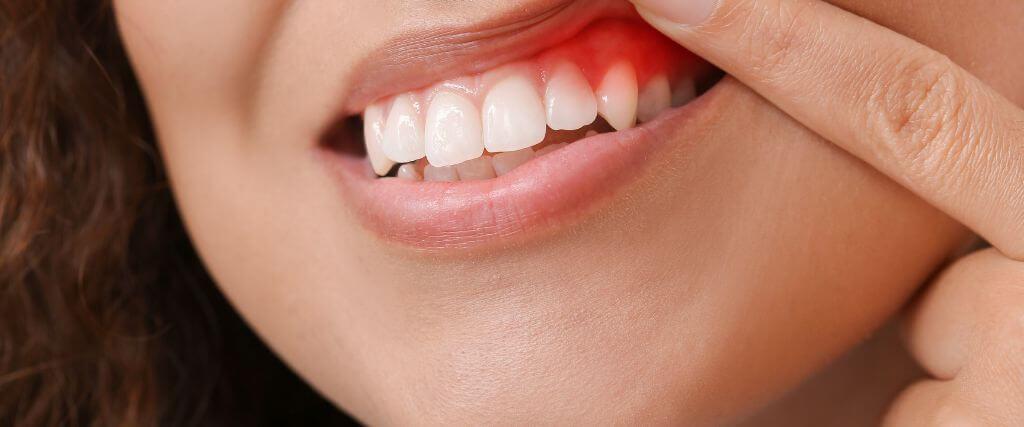Your mouth is a battleground. Every day, a microscopic war rages between the good guys (beneficial bacteria) and the bad guys (plaque-forming bacteria). When the bad guys win, your gums become inflamed, and a condition known as gingivitis sets in.
Don’t worry; this isn’t a horror story. It’s a common dental issue but one that needs your attention. As dental professionals, we see gingivitis every day and want to educate you on the causes of this all-too-common ailment, how to treat it, and how to prevent it.
What is Gingivitis?
Gingivitis is when your gums become irritated and inflamed, usually due to an unwelcome guest known as plaque. Plaque is a film teeming with bacteria that forms on teeth when leftover food particles and saliva mix. If not removed promptly, plaque hardens into calculus (tartar), which creates a stubborn haven for those pesky bacteria. This buildup irritates gum tissue, causing the telltale signs of gingivitis.
The Causes of Gingivitis
While poor oral hygiene — infrequent brushing and flossing — is the arch nemesis in the gingivitis drama, there are other factors at play, too.
Some of the most common causes of gingivitis are:
- Smoking and Tobacco Use: These habits weaken your immune system, making it harder for your body to fight off gum infection.
- Hormone Fluctuations: Pregnancy, puberty, and menstruation can trigger gum sensitivity, increasing the risk of gingivitis.
- Certain Medications: Some prescription medications cause dry mouth, which disrupts the balance of oral bacteria and promotes plaque buildup.
- Medical Conditions: Diabetes and other chronic illnesses can make you more susceptible to gum disease.
- Poor Nutrition: A diet lacking certain essential vitamins and minerals can lower your body’s ability to fight infections, including those in your gums.
Signs and Symptoms
Healthy gums are pale pink and firm. But if gingivitis has taken hold, your gums might be sending out some distress signals.
Symptoms of gingivitis include:
- Red, Swollen, or Puffy Gums: This is a classic sign of gingivitis. If your gums are red or inflamed, call your dentist.
- Bleeding Gums: Brushing or flossing shouldn’t be a bloody affair! If your gums bleed easily — even when using a soft toothbrush — it’s a telltale sign of gingivitis.
- Bad Breath (Halitosis): The bacteria in plaque cause an unpleasant odor. Bad breath has many potential causes, but gingivitis is among the most common.
- Mouth Tenderness: Gingivitis can make your gums sensitive to the touch. They may also be sensitive to heat or cold. Discomfort in your gums always warrants scheduling an appointment with your dentist.
How Your Dentist Will Diagnose Gingivitis
Your dentist will check your gums for gingivitis during your appointment. They’ll use a special tool to gently probe the depth of the space between your gums and teeth (called the pocket depth). Healthy pockets are shallow, while deeper pockets indicate gum inflammation.
Treatment Options
The good news is that gingivitis is very treatable.
Here are some tips for treating gingivitis:
- Step Up Your Oral Hygiene Game: Brushing twice every day with a soft-bristled brush and fluoride toothpaste is your primary weapon against plaque. Aim for a gentle yet thorough clean, reaching all surfaces of your teeth — especially the gum line.
- Floss Like a Boss: Flossing once a day removes plaque from between your teeth. Think of it as sneaking behind enemy lines to take out hidden plaque pockets.
- Schedule Routine Cleanings: Professional dental cleanings (scaling and root planing) are vital. During a scheduled cleaning, your dental hygienist will eliminate plaque and tartar buildup using specialized tools, leaving your gums squeaky clean.
- Use Mouthwash: While not a replacement for brushing and flossing, an antiseptic mouthwash can help reduce plaque and freshen your breath.
Preventing Gingivitis: Keeping Your Gums Happy
An ounce of prevention is always better than a pound of cure (and a hefty dental bill!).
Here’s how to keep your gums healthy and happy:
- Maintain a Consistent Brushing and Flossing Routine: Consistency is key! Daily brushing and flossing are your non-negotiables.
- Fuel Your Body Right: A healthy diet filled with vegetables, fruits, and whole grains gives your body the nutrients it requires to fight infections, including gum problems.
- Regular Dental Checkups: Schedule regular dental visits, usually every six months, for professional cleanings and exams.
- Quit Smoking: Smoking cigarettes/tobacco is one of the worst things you can do for your oral (and overall) health. Commit to quitting today.
Consequences of Untreated Gingivitis
While gingivitis might seem like a minor problem, leaving it unaddressed can have serious consequences.
Here’s why you shouldn’t ignore those inflamed gums:
- When left untreated, gingivitis can lead to periodontitis, a severe infection that damages the structures supporting your teeth. This can cause gum recession, loose teeth, and even tooth loss. It can also be painful.
- Research suggests there is a link between gum disease and other chronic health conditions like heart disease, stroke, and diabetes. Maintaining healthy gums isn't just about a pretty smile; it’s about your overall well-being.
Closing Thoughts
Gingivitis is a common but preventable dental issue. By prioritizing good oral hygiene, maintaining a healthy diet, and scheduling regular checkups, you can keep those plaque monsters at bay and ensure your gums stay healthy and happy.
Taking care of your gums is an investment in your health and well-being. So, don’t let gingivitis win the battle. With a little effort and the right knowledge, you can keep your smile bright and healthy for years to come.

